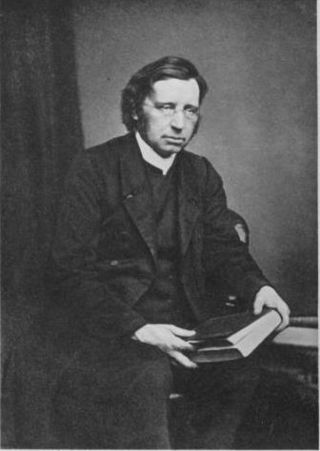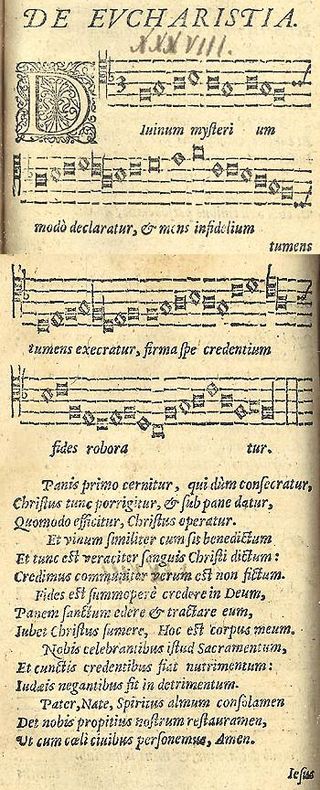Related Research Articles
Plainsong or plainchant is a body of chants used in the liturgies of the Western Church. When referring to the term plainsong, it is those sacred pieces that are composed in Latin text. Plainsong was the exclusive form of Christian church music until the ninth century, and the introduction of polyphony.

Gregorian chant is the central tradition of Western plainchant, a form of monophonic, unaccompanied sacred song in Latin of the Roman Catholic Church. Gregorian chant developed mainly in western and central Europe during the 9th and 10th centuries, with later additions and redactions. Although popular legend credits Pope Gregory I with inventing Gregorian chant, scholars believe that it arose from a later Carolingian synthesis of the Old Roman chant and Gallican chant.

Vespers is a liturgy of evening prayer, one of the canonical hours in Catholic, Eastern Orthodox, Oriental Orthodox, and Lutheran liturgies. The word for this prayer time comes from the Latin vesper, meaning "evening".

Septuagesima is the name for the ninth Sunday before Easter, the third before Ash Wednesday. The term is sometimes applied to the seventy days starting on Septuagesima Sunday and ending on the Saturday after Easter. Alternatively, the term is sometimes applied also to the period sometimes called pre-Lent that begins on this day and ends on Shrove Tuesday, the day before Ash Wednesday, when Lent begins.
Hallelujah is an interjection from the Hebrew language, used as an expression of gratitude to God. The term is used 24 times in the Hebrew Bible, twice in deuterocanonical books, and four times in the Christian Book of Revelation.
Alleluia is a phrase in Christianity used to give praise to God. In Christian worship, Alleluia is used as a liturgical chant in which that word is combined with verses of scripture, usually from the Psalms. This chant is commonly used before the proclamation of the Gospel. In Western Christianity, congregations commonly cease using the word Alleluia during the period of Lent but restore it into their services at Easter. The form of praise "Alleluia" is used by Christians to thank and glorify God; it finds itself present in many prayers and hymns, especially those related to Eastertide, such as "Christ the Lord is Risen Today".

Pre-Lent begins the Christian time of preparation for Easter, in the three weeks before Lent. This period launches a campaign of catechesis, reflected in the liturgical readings. Its best-known feature is its concluding three-day festival, Carnival or Shrovetide.

John Mason Neale was an English Anglican priest, scholar, and hymnwriter. He worked and wrote on a wide range of holy Christian texts, including obscure medieval hymns, both Western and Eastern. Among his most famous hymns is the 1853 Good King Wenceslas, set on Boxing Day. An Anglo-Catholic, Neale's works have found positive reception in high-church Anglicanism and Western Rite Orthodoxy.
Ambrosian chant is the liturgical plainchant repertory of the Ambrosian rite of the Roman Catholic Church, related to but distinct from Gregorian chant. It is primarily associated with the Archdiocese of Milan, and named after St. Ambrose much as Gregorian chant is named after Gregory the Great. It is the only surviving plainchant tradition besides the Gregorian to maintain the official sanction of the Roman Catholic Church.
Mozarabic chant is the liturgical plainchant repertory of the Visigothic/Mozarabic rite of the Catholic Church, related to the Gregorian chant. It is primarily associated with Hispania under Visigothic rule and later with the Mozarabs and was replaced by the chant of the Roman rite following the Christian Reconquest of the Iberian Peninsula. Although its original medieval form is largely lost, a few chants have survived with readable musical notation, and the chanted rite was later revived in altered form and continues to be used in a few isolated locations in Spain, primarily in Toledo.

"Of the Father's heart begotten" alternatively known as "Of the Father's love begotten" is a doctrinal hymn based on the Latin poem "Corde natus" by the Roman poet Aurelius Prudentius, from his Liber Cathemerinon beginning "Da puer plectrum" which includes the Latin stanzas listed below.

O filii et filiae is a Christian hymn celebrating Easter. It is attributed to Jean Tisserand, a Franciscan friar.

Let all mortal flesh keep silence, also known as Let all mortal flesh keep silent, is an ancient chant of Eucharistic devotion based on words from Habakkuk 2:20, "Let all the earth keep silence before him" and Zechariah 2:13, "Be silent, all flesh, before the LORD; for he has roused himself from his holy dwelling". The original was composed in Greek as a Cherubic Hymn for the Offertory of the Divine Liturgy of St James; it probably antedates the rest of the liturgy and goes back at least to AD 275, with local churches adopting arrangements in Syriac. In modern times, the Ralph Vaughan Williams arrangement of a translation from the Greek by Gerard Moultrie to the tune of "Picardy", a French medieval folk melody, popularized the hymn among other Christian congregations.
"Veni redemptor gentium" is a Latin Advent or Christmas hymn by Ambrose of Milan in iambic tetrameter. The hymn is assigned to the Office of Readings for Advent, from 17 December through 24 December, in the Liturgy of the Hours. John Mason Neale and Thomas Helmore saw it as an Evening hymn for the period from Christmas to the eve of Epiphany.

"All Glory, Laud and Honour" is an English translation by the Anglican clergyman John Mason Neale of the Latin hymn "Gloria, laus et honor", which was written by Theodulf of Orléans in 820. It is a Palm Sunday hymn, based on Matthew 21:1–11 and the occasion of Christ's triumphal entry into Jerusalem.
Hymnody in continental Europe developed from early liturgical music, especially Gregorian chant. Music became more complicated as embellishments and variations were added, along with influences from secular music. Although vernacular leisen and vernacular or mixed-language carols were sung in the Middle Ages, more vernacular hymnody emerged during the Protestant Reformation, although ecclesiastical Latin continued to be used after the Reformation. Since then, developments have shifted between isorhythmic, homorhythmic, and more rounded musical forms with some lilting. Theological underpinnings influenced the narrative point of view used, with Pietism especially encouraging the use of the first person singular. In the last several centuries, many songs from Evangelicalism have been translated from English into German.

"Ye Choirs of New Jerusalem" or "Sing, Choirs of New Jerusalem" is an English Easter hymn by Robert Campbell. It is a 19th-century translation of the medieval Chorus novae Ierusalem, attributed to Fulbert of Chartres. The text's primary focus is the Resurrection of Jesus, taking the theme of Jesus as triumphant victor over death and deliverer of the prisoners from Hell.
"Christ Is Made the Sure Foundation" is a Christian hymn, translated in 1851 by John Mason Neale from the second part of the 6th- or 7th-century Latin monastic hymn Urbs beata Jerusalem.

"Christians, awake, salute the happy morn" is an English Christmas hymn on a text by John Byrom. It is usually sung to the tune "Yorkshire" by John Wainright.
Alleluia piis edite laudibus, also known as Alleluia perenne, is a medieval Latin hymn sung during the week before Septuagesima as a preparation for the dismissal of "Alleluia" during Lent.
References
- 1 2 Julian, John (1892). A Dictionary of Hymnology: Setting Forth the Origin and History of Christian Hymns of All Ages and Nations, with Special Reference to Those Contained in the Hymn Books of English-speaking Countries, and Now in Common Use, Together with Biographical and Critical Notices of Their Authors and Translators, and Historical Articles on National and Denominational Hymnody, Breviaries, Missals, Primers, Psalters, Sequences. C. Scribner's Sons. p. 48.
- ↑ Headlam, Arthur Cayley (1884). The Church Quarterly Review. Spottiswoode. p. 241.
- ↑ "Alleluia, best and sweetest". Hymnary.
- 1 2 3 "Alleluia, song of gladness". Hymnary.
- ↑ Helmore, Thomas (1852). Accompanying Harmonies to the Hymnal Noted. J.A. Novello. p. 235.
- ↑ Langbroek, Erika; Roeleveld, Annelies; Quak, Arend; Vermeyden, Paula (2005). Amsterdamer Beiträge Zur Älteren Germanistik, Band 60 (2005) (in German). Rodopi. p. 78. ISBN 978-90-420-1697-2.
- ↑ Neale, J.M. (1863). Mediæval hymns and sequences.